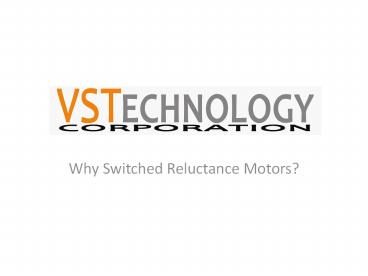Why Switched Reluctance Motors? - PowerPoint PPT Presentation
1 / 9
Title:
Why Switched Reluctance Motors?
Description:
Dimensions, Volumes & Weight Comparisons of the 3 Motor Types (NEMA 184 T Frame) ... shoot through faults, unlike the inverters of induction and brushless dc motors. ... – PowerPoint PPT presentation
Number of Views:2974
Avg rating:3.0/5.0
Title: Why Switched Reluctance Motors?
1
- Why Switched Reluctance Motors?
2
Lets Focus on 3 Motor Types
- AC Induction
- Brushless DC
- Switched Reluctance
3
AC Induction
Source AC, Brushless, Switched Reluctance Motor
Comparisons James R. Hendershot, Magna Physics
Corporation
4
Brushless DC
Source AC, Brushless, Switched Reluctance Motor
Comparisons James R. Hendershot, Magna Physics
Corporation
5
Switched Reluctance
Source AC, Brushless, Switched Reluctance Motor
Comparisons James R. Hendershot, Magna Physics
Corporation
6
Dimensions, Volumes Weight Comparisons of the 3
Motor Types (NEMA 184 T Frame)
Source AC, Brushless, Switched Reluctance Motor
Comparisons James R. Hendershot, Magna Physics
Corporation
7
Motor Comparison for BEVs HEVs
Source Advantages of Switched Reluctance Motor
Applications to EV and HEV Design and Control
Issues M. Ehsani, et al, IEEE Transactions on
Industry Applications, Vol. 36, No 1,
January/February 2000
8
What About Noise?
9
In Summary
- Due to the absence of rotor windings, SRM is very
simple to construct, has a low inertia and allows
an extremely high-speed operation. SRM operates
in constant torque from zero speed up to the
rated speed. Above rated speed up to a certain
speed, the operation is in constant power. The
range of this constant power operation depends on
the motor design and its control. Designing a
motor with high constant power range to base
speed (e.g. at least 41), is not hard to achieve
with SRM, and has a great effect in designing a
lower power motor that can produce significant
torque. - The absence of rotor copper loss eliminates the
problem that the induction motor has associated
with rotor cooling due to its poor thermal
effects. The absence of permanent magnets on the
rotor eliminates the problem that the Brushless
DC motor has with high temperature environments
whereby the magnets can lose their magnetization. - The SRM has many advantages, mostly resulting
from its simple structure. SRM is normally low
cost because of its extremely simple
construction. Moreover, The SRM operation is
extremely safe and the motor is particularly
suitable for hazardous environments. The SRM
drive produces zero or small open circuit voltage
and short circuit current. - Furthermore most SRM converters are simple
because the current is unipolar. The SRM drive is
immune from shoot through faults, unlike the
inverters of induction and brushless dc motors.
Due to the inductive nature of the motor, the
power factor of the SRM is lower and requires a
higher rated converter when compared to induction
or BLDC motors.































